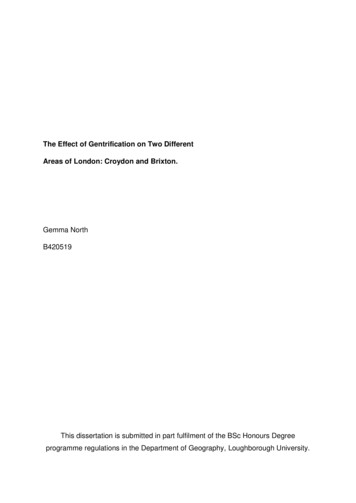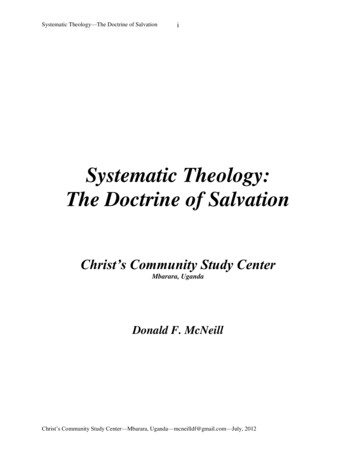
Transcription
The Effect of Gentrification on Two DifferentAreas of London: Croydon and Brixton.Gemma NorthB420519This dissertation is submitted in part fulfilment of the BSc Honours Degreeprogramme regulations in the Department of Geography, Loughborough University.
The Effect of Regeneration in Croydon and BrixtonTable of Contents:Abstract 2Key words . 2Introduction . 3Literature Review . 4Methodology 13Analysis and Discussion of Results . 18Conclusion . 23Acknowledgements 25References . 28List of Tables . 37List of Figures . 38Appendices . 561
The Effect of Regeneration in Croydon and BrixtonAbstractThis dissertation examines the economic effects of regeneration to both businessesand local residents in two areas of London, Croydon and Brixton. It seeks to discoverwhether the impacts experienced by two different areas of London are similar andwhether they are beneficial to the areas or if they generate negative impacts such asthe loss of local businesses and residents. The understanding of regeneration andthe impacts of regeneration is a field of study which has experienced increasingimportance due to the policies and methods constantly adapting to reflect therequirements and factors of importance at the time of regeneration. The researchundertaken adopted a mixed-methods approach, comprising of interviews,questionnaires and secondary data. Through which the information gatheredidentified the direct and indirect economic benefits of the regeneration schemeswithin the areas of Croydon and Brixton. The findings in this report indicate that theregeneration schemes, with a specific focus on Boxpark and Pop Brixton, have aidedthe economic improvement of both Croydon and Brixton. It highlighted that despitethe differentiation in areas, the similar regeneration schemes both had a vast amountof beneficial impacts for the area. Despite much literature focusing on the negativeimpacts of regeneration, such as business loss and displacement, although, this didoccur within both areas, the negative impacts were very insignificant in light of thepositive economic impacts the area has felt. This study also highlights thesignificance of the role of media in the regeneration schemes. Following suchfindings, this dissertation offers suggestions into a new research approach andcorrelations to further be examined within different regeneration projects which areoccurring.Keywords: London, regeneration, mixed-methods approach, displacement,effect, economy.2
The Effect of Regeneration in Croydon and Brixton1. IntroductionRegeneration is a phenomenon which is widely experienced (Roberts and Sykes,1999:3). In the UK, regeneration was sparked by the post-industrial decline withincities of the 1980’s. The decline of once prominent industries within cities led toeconomic, social, environmental and physical decline of the cities (Tsenkova andBeswick, 2002), creating a need for the cities to be rejuvenated and given a newlease of life. It is widely recognised that a conscious effort from local and regionaldevelopment agencies is required to recreate an economic base for an area whichhas been subject to decline (Paddison, 1993). Thus, inward investment is oftensought after to establish regeneration within a city or area of a city, leading to thecreation of new sites which attract people to the area. Alongside the creation of newsites, the reuse of brownfield land and existing buildings is also emphasised, due toa lack of space for new sites to be created within cities (Hall, 1996).In respect of this, it is important to understand the challenges facing the regenerationof an area, as there is an increasing need for regeneration to encapsulate the lastingculture and legacy of the individuals and businesses residing in the area. Stevenson,(2013) mentions the growing impact and consideration for culture and legacy onregeneration. The importance of design and purpose of the regeneration hasbecome the forefront of planning changes for an area. The World Bank, (no date)suggests that the design of the regeneration of an area is key as it not onlygenerates economic value but also social and environmental value. Nonetheless, notonly do regeneration projects need to be physically appealing and beneficial for thearea, they need to enhance the area without completely eradicating what is alreadythere (Roberts, Sykes and Granger, 2016) In conjunction with this, as regeneration isoften linked to an escalation of wealth within an area, which can lead todisplacement, requiring councils to implement mitigating policies. (The World Bank,no date b) However, the benefits are often overlooked, as they are shadowed by thenegative impacts such as displacement and urban problems (Atkinson, 2003;Newman and Wyly, 2016). Regeneration has been found to improve the crime rate inan area, thus, making an individual feel safer and secure within the area (Kearns,2003). There is a great deal of literature around the process of regeneration as wellas case studies examining the effectiveness of urban regeneration, within the UK3
The Effect of Regeneration in Croydon and Brixtonand many other cities globally. It is evident that the impacts of regeneration havebeen looked at extensively and are widely understood by researchers, however, themain impact focused on within literature is displacement and there is little researchregarding the economic impacts of urban regeneration in specific areas.Although research has looked at the impacts of regeneration, it is argued that urbanproblems differ from place to place (The Local Government Organisation, 1989:1)Therefore, further research regarding such a complex, widely experiencedphenomenon will add to the debate. This dissertation seeks to examine a variety ofeffects of regeneration, how the regeneration has affected the views of those whouse the area, exploring the degree to which regeneration impacts the local economy,looking at both businesses and residents within the areas. The main researchobjectives are: i) To evaluate how regeneration has impacted the economy within theselected areas of Croydon and Brixton; ii) To investigate the impact urbanregeneration in Croydon and Brixton has affected local businesses and; iii) Toexplore if regeneration has affected the reputation of the area and whether thisbrings more people to the area.The dissertation has six main chapters, beginning with a literature review of previousresearch that exists, focusing on how regeneration has changed overtime to equateto an economic focus and the impacts of regeneration. Following on from this, it thencreates an outline and justification of the various data collection and analysismethods adopted. Before moving on to discuss the findings in relation to literatureand approaches mentioned in previous chapters. Finally, it concludes by looking atthe findings within a wider context, drawing out the impacts in relation to those seenin previous research and exploring what could be learnt from the regenerationoccurring in these areas and how this has developed upon and aided previousresearch.2. Literature ReviewIn order to examine the effects of regeneration in two areas of London, this literaturereview will evaluate the existing academic work on regeneration, observing changesto regeneration throughout history. Furthermore, the concept of economicimportance within a regeneration concept will be introduced. Additionally, a line of4
The Effect of Regeneration in Croydon and Brixtonstudy within the concept of the impacts of regeneration will be explored, with thediscussion on the known impacts and how other places have been affected byregeneration. With the intention of demonstrating how these three aspects haveshaped the current regeneration practices, highlighting why this study is both highlyimportant but also interesting.2.1. What is regeneration? A history(Roberts, Sykes and Granger, 2016) define regeneration as a:‘Comprehensive and integrated vision and action which seeks to resolve urbanproblems and bring about a lasting improvement in the economic, physical, socialand environmental condition of an area that has been subject to change or offersopportunities for improvement’This is a widely accepted definition for urban regeneration and it has beenacknowledged as the definition used for many studies, including but not restricted to,Balsas (2007:233), Tallon (2010:5), Balaban, (2012:32). It is important to highlightthat regeneration engages with three areas for improvement, economic, physical andsocial. In light of this definition, urban regeneration has adapted over the years tosuit the requirements of both the place and time. Urban regeneration was firstdeveloped after World War II, in the form of rebuilding the destructed towns andcities (Couch, Sykes and Cocks, 2013:34). However, this focused largely on therebuild of housing. A new form of urban regeneration emerged when the ‘moderncity’ was established, due to the rebuilding of industrial cities (Fox-Przeworski,Goddard and De Jong, 1991:2). The economic crisis of the 1970s caused masseconomic restructuring, the cities whose economies previously relied on industrialsectors such as mining or steel, were hardest hit (Couch, Sykes and Cocks, 2013).As the deindustrialisation lead to the rapid decline and dereliction of towns and cities,there was a need to improve and bring the areas purpose and life again (Tallon,2010). Causing a movement from the development of housing as an urbanregeneration focus to local economic development (Bianchini and Parkinson, 1993).There was a growing need to generate more employment opportunities, throughwhich the UK government opted to back Urban Development Corporations (UDCs).UCDs were bought into an area to bring use to derelict buildings and land, thedevelopment of these sites bought new appeal and industry to the areas, in turn5
The Effect of Regeneration in Croydon and Brixtoncreated jobs (Imrie and Thomas, 1999). It is evident that urban regeneration policywithin the UK continued to focus on economic development and prosperity as, TheLocal Government Organisation (1989) notes that in ‘The Queens Speech’ (1987)she states ‘action will be taken to encourage investment and to increase enterpriseand employment’. It is therefore, evident that economic improvement is a continuingtheme of urban regeneration.Despite a continuing theme of economic development being the forefront of urbanregeneration, as times change so do other factors impacting urban regeneration.(Roberts and Sykes, 1999), understand that ‘each generation faces its own particularset of problems, has its own priorities and works in ways which reflect thesepriorities’. It is evident these priorities have changed throughout time and depend onwhat is seen as important. For example, (Couch, Sykes and Cocks, 2013) recognisethat in the 1960s the conservation of urban heritage was considered of increasingimportance, something which had previously been of low importance. Therefore,coming from the 1960s forward, sites deemed of importance to a place in terms ofculture and heritage were protected. Another example (Couch, Sykes and Cocks,2013) note is that more recently both traffic and social considerations have been keyin urban regeneration plans. As well as this, environmental issues and sustainabilityhave also been highlighted as an urban regeneration problem (Roberts, Sykes andGranger, 2016). It is important that as each generation faces its own problems it alsolearns from previous experience (Roberts and Sykes, 1999). Therefore, it is clear tosee that overtime different aspects have been considered a priority whenregenerating a city and planning the regeneration of a city. Thus, reflecting theimportance of time and location within city regeneration. (Roberts and Sykes, 1999),recognise that change within cities is inevitable and happens overtime, makingregeneration something that should be viewed as beneficial.Regeneration is now a phenomenon widely experienced within cities or parts of acity, in an attempt to ‘reverse the ‘vicious spiral’ in which physical, economic andsocial problems reinforce each other’ (Coombes, Raybould and Wong, 1992:2).Therefore, it is widely recognised that regeneration is linked to improving areaswhich have been subject to recent decline (Home, 1982; Tallon, 2010; Leigh andBlakely, 2016). The decline of a city affects multiple factors, from these, the6
The Effect of Regeneration in Croydon and Brixtoneconomic, social and physical aspects of a city are recognised to be at the forefrontof regeneration plans (Home, 1982; Leary and McCarthy, 2013:1;(Turok, 2005)ascited in Tallon, 2010). Within these umbrella concepts are many challengesdevelopers and local governing bodies face, subject to the areas demands andneeds. (Roberts and Sykes, 1999), understand that to tackle these problems andmake a lasting change, all available resources, both human and financial must beoptimised.2.2 Economy as the driver for regenerationIn light of research distinguishing three main aspects of urban regeneration, it isargued that the most prominent of the three is the economic aspect. From the 1980s,the economy has been a driving force for development and regeneration, with afocus on a strong economy bringing new vitality to cities (‘Prime Ministers Speech’,1988, as cited in (The Local Government Organisation, 1989:4). It can be seen that‘many local communities have ‘become dependent on money coming from outsideand going straight out again, not circulating locally and supporting local work’’(Robertson, 1987:59 as cited in Stöhr, 1990:36). The economic restructuring anddecline of an area often leads to the need to regenerate, as it can have severeconsequences (Couch, Sykes and Cocks, 2013). Consequences such as derelictionof buildings and land, as the area becomes rundown. Thus, people are less likely tovisit it, leading to the closure of businesses due to a decrease in income causing aloss in earning which subsequently, leads to further decline.However, in terms of regeneration, derelict buildings ‘provide a convenient physicalfocus for action to bring about economic restructuring’ (Turok, 1992:373) andinvestment creates use for obsolete buildings and vacant land (McArthur, 1993).There has been a focus on the development of brownfield sites and derelict buildingswithin cities as, there is a growing lack of space which can be developed upon (Leighand Blakely, 2016). Aldous (1988), notes that landscape is important when designinga new development, considering that derelict land and buildings provide a hotspot forregeneration projects to occur. There is an argument regarding the sustainability ofupcycling and reuse of buildings for a new purpose rather than simply restoring ordestroying them (Aldous, 1988; Ball, 1999; Bullen and Love, 2011; Couch andDennemann, 2000). Following from this, (Aldous, 1988) also recognises that existing7
The Effect of Regeneration in Croydon and Brixtonbuildings have value as established elements in the townscape, adding to the areasidentity. Supporting this, places and place attachment are perceived as importantwithin people’s lives (Ujang and Zakariya, 2015, p. 710), significant structuralelements add self-identity, sense of community and sense of place to an area (Ujangand Zakariya, 2015, p. 710). Therefore, to give the building a new use attractsattention and excitement, a new buzz, in turn bringing people to the area, togenerate more income to the area.The economy is the basis for urban redevelopment (Couch and Dennemann, 2000,p. 137), through which inward investment brings high prospects and a brighter futureto an area, by generating long term aid and job creation (Coombes, Raybould andWong, 1992). It is understood that the more money that goes into a project, thebetter the outcome, as it is typically nicer and more desirable (Aldous, 1988).Therefore, the more money that goes into a regeneration project, the moreprosperous the outcome. Government policies were created to help aid regenerationin areas most in need (The White Paper, 1977 as cited in The Local GovernmentOrganisation, 1989). An example of government policies can be seen as:‘Urban regeneration programmes whose priorities as set out in ‘Action for Cities’(The Cabinet Office, 1988), are to; encourage enterprise, improve job prospects,make areas attractive to residents and business; and make inner city areas safe andattractive places’ (Coombes, Raybould and Wong, 1992, pg.2).Therefore, to improve an area, it is widely understood that economic values areimportant, as three out of the four priorities mentioned above relate to the generationof economic gain and prosperity. The improvement of a city’s economy provideshope and prospect for better things to come (Henderson, 2002). With theimprovement of a city’s economy comes a number of impacts which lead to theoverall improvement of the area, which is at the forefront of urban regenerationdesign. Department of the Environment (1994:158 as cited in Couch andDennemann, 2000) recognise that the sustainable development of citiesencompasses the areas in the most efficient way whilst improving the aesthetics ofthe area for work, leisure and living. Understanding that economic regeneration willbring work and people to the area. Depleted economies need investment to bringmoney in and start money circulating the economy again, once this begins the area8
The Effect of Regeneration in Croydon and Brixtonwill improve and improvements will last. This can be achieved through a number ofmeans, both from private and public investment.In 1978, the Urban Areas Act gave local authorities more power to help industrywithin the area, allowing for economic gain (Gibson and Langstaff, 1982). Forregeneration projects to be successful, it is argued that a mix of both public andprivate regeneration schemes is ideal, despite private investment becoming a keydriver for regeneration (Roberts and Sykes, 1999). The Local GovernmentOrganisation (1989) states that ‘there is increasingly wide acceptance that theprivate sector is the primary engine of urban regeneration and that the public sectorsrole is to facilitate the process’. Local governments are able to aid regenerationthrough the allocation of land to businesses and developers at decreased rates inorder to generate jobs (Morrison, 1987). Moreover, it is understood that influencefrom and communication between a variety of groups is key in developing lasting,effective and purposeful regeneration projects. Roberts and Sykes (1999) agree that‘regeneration involves the public, private, community and voluntary sectors workingtogether towards a clear simple aim - to improve the quality of life for all.’ Enhancingthe idea that regeneration projects need to encompass a mix of schemes fromdiffering investment bodies.Public investment from the government and local governing bodies provides bothleadership and encourages enterprise (The Local Government Organisation, 1989,p. 14). The role of the local governments in urban regeneration is important as theyhave the means to promote their areas to investors and companies to draw moneyand developments to the area (Friedman, Gerlowski and Silberman, 1992). As wellas this, local governments have the means to improve education and training asarguably the most important limitation to economic development is the supply of awell-educated and trained labour force (The Local Government Organisation, 1989,p. 13). Therefore, new businesses coming into an area is only beneficial if there is aworkforce with the skills and requirements to carry out the work. Local governmentsalso provide support to independent businesses through means of financial aid,training to ensure they have adequate workers and schemes to help localbusinesses adapt their business plans (Blair, 1998). Links can be generatedbetween disadvantaged social groups and the private sector through the council,9
The Effect of Regeneration in Croydon and Brixtonwhich would hopefully ensure that all groups benefit from the regeneration of an area(The Local Government Organisation, 1989). It is evident that the LocalGovernments see the benefit of working with private investors, this is important asprivate investment is now the driver for urban regeneration projects.While investment is seen as a necessary part of economic development, it oftencomes from private investors, companies bought into an area for cheap land onwhich to create their business. A variety of private investor schemes are seen withinurban regeneration, one that has been prominent is the development of shoppingcentres and flagship stores (Coombes, Raybould and Wong, 1992, p. 9). Flagshipstores can aid regeneration as they create a sense of prestige through which otherstores, chains and regeneration projects follow (Kent and Brown, 2009, p. 8).(Bianchini, Dawson and Evans, 1992) defined flagship projects as ‘significant, highprofile developments that play an influential and catalytic role in urban regeneration,which can be justified if they attract other investment’. Therefore, retail developmentscan prove important in the redevelopment of a city, as they create further economicactivity (Smith, 1994) explaining why they have become significant in regenerationschemes (Loftman and Nevin, 1995, p. 300).Another example of a private investment regeneration project is the transformation ofderelict buildings or brownfield sites into workspaces, as well as the creation of newplaces for workspaces. ‘There are over 800,000 small and medium-sized enterpriseswithin London’ (Mayor of London, 2015:3) not including others who also workindependently. With it becoming increasingly hard to find affordable workspace,there is a huge market in which to provide accessible and affordable workspace forthese people. With buildings empty and rotting away, the development ofworkspaces is both an appealing venture and highly beneficial to start-up businesses(Ferm, 2014, p. 18). Especially if an area is also regenerating through other meansat the same time, as the other regeneration projects will bring attention and appeal tothe area, bringing with it, businesses who now wish to locate within this area (Adairet al., 2009). Thus, supporting the earlier point that retail and flagship regenerationprojects generate further appeal for the area from other business sectors.2.3 Impacts of regeneration10
The Effect of Regeneration in Croydon and BrixtonIt is understood that ‘the more economically depressed an area is, the more it needsreally superlative quality in redevelopment in order to repair its fortunes andreputations’ (Aldous, 1988). The quality of regeneration is important as it is meant tobe a lasting improvement, the more declined an area, the worse the pretence forregeneration is so more work is needed. However, it can be hard for councils to findprivate investors to kick start the regeneration of an area as reputation is a keyelement to attracting private investment (Anholt, 2007, p. 2). Reputation of an areais important as it is not only linked to the attraction of businesses and privateinvestors to an area but also to the attraction of visitors to the area (Maruthaiah andRashid, 2014) If an area is run down it is likely to be seen as a poor area, high crimerates are also linked to areas in need of regeneration (Hancock, 2013, p. 129)therefore, people do not wish to visit the area. An approach to change this is forpublic led investment to focus on creating a clean and safe environment as it will putthe city in a better position to attract both town users and investors (Otsuka andReeve, 2007, p. 445). Otsuka and Reeve (2007, p. 445), suggest that a safe andattractive environment is key to sustain a city’s economic vitality and generateinvestment. This is reiterated by McArthur (1993, p. 73) in evaluating the strategiestaken to improve job prospects in Glasgow he mentions there was a strategy tocreate an attractive, modern and well-serviced environment for business. Theimprovement of an areas reputation and the attraction of both businesses,investment and public leisure leading to expenditure, is an impact of regenerationand aids the increase and development of an area’s economy further.However, an impact of city centre regeneration and the improvement of reputation isthat it can transform the area and create a sense of exclusivity for those who are welloff (Otsuka and Reeve, 2007, p. 445). It is often argued that economic regenerationas a focus for development causes the ‘removal of low-income working-class groupsas potential users of prestige developments’ (Otsuka and Reeve, 2007, p. 445).Therefore, causing segregation and displacement, two negative impacts of urbanregeneration which are highly publicised and reviewed within both literature and themedia (The World Bank, no date b; Turok, 1992; Smith, 2002; Cameron, 2003; Lees,2013) Despite this, many councils and governing bodies implement policies to tryand mitigate displacement of both residents and local, independent businesses.11
The Effect of Regeneration in Croydon and BrixtonThrough the training of residents so they have the skills required to take up the newjob opportunities present through the regeneration.Job creation is an important impact of urban regeneration as it allows for localresidents to benefit from the regeneration. As local residents benefit from jobs andmore disposable income, the town centres also benefit from a new array of leisureactivities allowing increased expenditure being kept within the area, rather thanbeing spent in surrounding areas like it once was (Otsuka and Reeve, 2007, p. 453.).However, job creation may not always benefit the disadvantaged and marginalworkers (McArthur, 1993). Many local governments aid the disadvantaged byproviding further training and education to get those less fortunate into work. Anexample of this can be seen in the Department for Communities and LocalGovernment (2012) where the Welfare Reform policy was generated to help givepeople the support they need to encourage them to get back into work.A further impact of regeneration is the improvement of infrastructure within the area.These infrastructure improvements are usually to facilitate the rise in footfall andpeople moving to the areas, ensuring the train stations, roads and pavements canhandle the extra traffic, as well as, the provision of extra housing to help mitigatedisplacement. Examples of infrastructure improvements are highlighted in a book onthe Aspects of Britain Urban Regeneration, produced by the Central Office ofInformation, 1995, presenting the infrastructural developments of BirminghamHeartlands and the Black Country. (Central Office of Information, 1995) notes thatthe infrastructure improvements within these areas help to aid business within theareas as there is improved access to the area.Therefore, it is clear to see that there are many impacts of regeneration projects,spanning a vast range of areas. It is also evident that the extensive impacts ofregeneration have both positive and negative effects on those residing or workingwithin and using the area. A final point to note is that the impacts of regenerationoften interlink and with one impact usually comes another, for example, theimprovement of infrastructure or reputation will bring attraction from businesses,which in turn creates jobs.12
The Effect of Regeneration in Croydon and Brixton3. Methodology3.1 Study SitesThe study focused on two areas of London (Figure 1); Croydon (Figure 2) andBrixton (Figure 3), both located in South London. These locations were chosen asthey are both areas of London which have recently and are continuing to regenerate.As Brixton is more central to London, with Croydon located slightly further away, intothe suburbs, an interesting dichotomy is created between the two locations. Bothlocations are alike as there are some similar regeneration initiatives occurring in theareas, Pop Brixton (Brixton, seen in Figures 4 and 5) and Boxpark (Croydon, seen inFigures 6 and 7). The population composition of the areas along with the economicstatus of both areas creates an interesting comparison with some figures similar andothers quite differing.The total population of Brixton as of 2015 is 82,516 (Lambeth and Southwark’sPublic Health Intelligence Team, 2015) and the total population of Lambeth is327,900 (Nomis, 2018b), this is very different to Croydon, where the population is382,300 (Department of Public Health, 2017). The ethnic mix within both areasdiffers slightly, with 49.3% of Croydon’s population being white and 50.6% Black,Asian and Minority Ethnic (BAME) (Department of Public Health, 2017). Lambeth’spopulation is 56% white and 44% BAME (Lambeth and Southwark’s Public HealthIntelligence Team, 2015). The population composition differs in age between bothLambeth and Croydon as the economically active population (those who are aged16-64) of Croydon is 64.7%, whereas the working age population in Lambeth isconsiderably higher at 74.6% (Nomis, 2018a). Therefore, the amount of peoplewithin each area who can contribute to the economy is considerably different.Furthermore, the average gross weekly pay of residents in Croydon is 631.80compared to Lambeth which is 670.50 (Nomis, 2018a). It is evident from thesestatistics that there are some clear similarities and differences between thepopulation composition of the two areas that will provide for an interestingcomparison.However, it is evident that they differ in their proximity to central London, their socioeconomic composition and despite the simi
development agencies is required to recreate an economic base for an area which has been subject to decline (Paddison, 1993). Thus, inward investment is often . Despite a continuing theme of economic development being the forefront of urban regeneration, as times change so do other factors impacting urban regeneration. (Roberts and Sykes .










